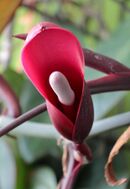Biology:Philodendron erubescens
| Philodendron erubescens | |
|---|---|

| |
| Scientific classification | |
| Kingdom: | Plantae |
| Clade: | Tracheophytes |
| Clade: | Angiosperms |
| Clade: | Monocots |
| Order: | Alismatales |
| Family: | Araceae |
| Genus: | Philodendron |
| Species: | P. erubescens
|
| Binomial name | |
| Philodendron erubescens K.Koch & Augustin
| |
Philodendron erubescens, the blushing philodendron or red-leaf philodendron, is a species of flowering plant in the family Araceae, native to Colombia.[1][2] It is a robust evergreen climber growing to 3–6 m (10–20 ft), with red stems and heart-shaped leaves up to 40 cm (16 in) in length. The flowers are deep red, fragrant spathes up to 15 cm (6 in) long, in summer and autumn.[3][4] The specific epithet erubescens means "blushing".[5]
Horticulture
With a minimum temperature of 15 °C (59 °F), in temperate regions it must be grown under glass or as a houseplant. It prefers indirect or filtered sunlight but will also tolerate lower light conditions. Similarly high humidity is ideal but it will manage with less.[6]
More than a dozen hybrid cultivars of P. erubescens can commonly be found in cultivation, including 'Black Cardinal', 'Birkin' , 'Burgundy' , 'Green Emerald', 'Green Princess', 'Imperial Green', 'Imperial Red', 'McColley’s Finale', 'Moonlight', 'Pink Princess', 'Prince of Orange', 'Red Emerald', 'Rojo Congo', 'White Princess', and 'White Wizard'.[6][7][8]
Most of these cultivars are considered “self-heading”, and not climbing; in time, they form dense, compact colonies of individual plants, originating from a single larger stalk.[6] The species, as well as some cultivars, have gained the Royal Horticultural Society's Award of Garden Merit.[9]
All parts of P. erubescens are toxic due to calcium oxalate and should be kept away from pets and young children.[6]
References
- ↑ "Philodendron erubescens" (in en). Royal Botanic Gardens, Kew. http://www.plantsoftheworldonline.org/taxon/87759-1.
- ↑ "RHS Plant Selector - Philodendron erubescens". https://www.rhs.org.uk/Plants/69146/Philodendron-erubescens/Details.
- ↑ RHS A-Z encyclopedia of garden plants. United Kingdom: Dorling Kindersley. 2008. pp. 1136. ISBN 978-1405332965.
- ↑ "Exotic Rainforest - Philodendron erubescens". http://www.exoticrainforest.com/Philodendron%20erubescens%20pc.html. Retrieved 28 June 2013.
- ↑ Harrison, Lorraine (2012). RHS Latin for gardeners. United Kingdom: Mitchell Beazley. pp. 224. ISBN 9781845337315.
- ↑ 6.0 6.1 6.2 6.3 Russ, K; Pertuit, A; Smith, B. "Philodendron factsheet". Clemson University. https://hgic.clemson.edu/factsheet/philodendron-pothos-monstera/.
- ↑ "Philodendron 'Pink Princess' - Aroid Cultivar Wiki". http://www.aroid.org/cvwiki/index.php/Philodendron_‘Pink_Princess’.
- ↑ Donovan, J. "Philodendron Erubescens Care Guide". https://lawn.com.au/philodendron-erubescens/.
- ↑ "AGM Plants - Ornamental". Royal Horticultural Society. July 2017. p. 76. https://www.rhs.org.uk/plants/pdfs/agm-lists/agm-ornamentals.pdf. Retrieved 24 April 2018.
Wikidata ☰ Q4484253 entry
 |


